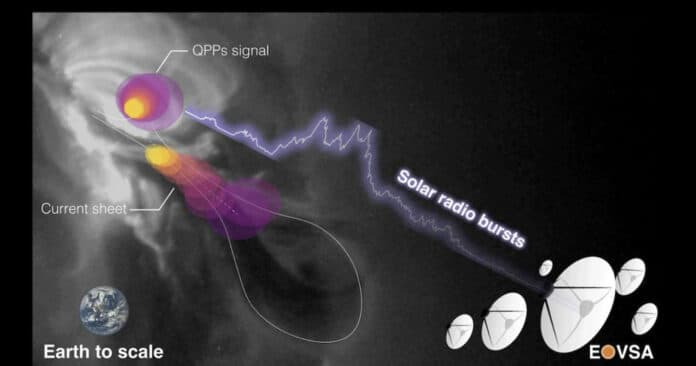Quasi-periodic pulsations (QPPs) are frequently detected in solar and stellar flares, but the underlying physical mechanisms are still to be ascertained. In a new study, an international team of researchers has reported an unexpected discovery of a solar radio burst with a signal pattern akin to a heartbeat.
This heartbeat-like radio burst has been pinpointed in the Sun’s atmosphere.
After examining microwave observations of a solar flare event on July 13, 2017, recorded by NJIT’s radio telescope called the Expanded Owens Valley Solar Array (EOVSA), which is located at Owens Valley Radio Observatory (OVRO), close to Big Pine, California, the team was able to identify the source of these pattern signals. The source location of a radio signal coming from within a C-class solar flare more than 5,000 kilometers above the Sun’s surface.
Scientists noted, “The study’s findings could help scientists better understand the physical processes behind the energy release of solar flares — the solar system’s most powerful explosions.”
Sijie Yu, the study’s corresponding author and astronomer affiliated with NJIT’s Center for Solar-Terrestrial Research, said, “The discovery is unexpected. This beating pattern is important for understanding how energy is released and dissipated in the Sun’s atmosphere during these mighty explosions on the Sun. However, the origin of these repetitive patterns, also called quasi-periodic pulsations, has long been a mystery and a source of debate among solar physicists.”
The team discovered a strong quasi-periodic pulsation (QPP) signal at the bottom of an electric current sheet that extended over 25,000 kilometers through the eruption’s core flaring region, where opposing magnetic field lines approached, broke apart, and then reconnected to produce the intense energy that powered the flare.
Yuankun Kou, a Ph.D. student at Nanjing University (NJU), said, “From EOVSA’s observations of the flare, the team revealed radio bursts featuring a signal pattern repeating every 10-20 seconds, ‘like a heartbeat.’
“But surprisingly, they discovered a second heartbeat in the flare.”
“The repeating patterns are not uncommon for solar radio bursts. But interestingly, there is a secondary source we did not expect located along the stretched current sheet that pulses similarly as the main QPP source.”
Yu said, “The signals likely originate from quasi-repetitive magnetic reconnections at the flare current sheet. This is the first time a quasi-periodic radio signal located at the reconnection region has been detected. This detection can help us to determine which of the two sources caused the other one.”
The team detected the energy spectrum of electrons at the two radio sources in this event using the special microwave imaging capabilities of EOVSA. EOVSA’s spectral imaging gave them new spatially and temporally resolved diagnostics of the flare’s nonthermal electrons.
Bin Chen, associate professor of physics at NJIT and co-author of the paper, said, “We found the distribution of high-energy electrons in the main QPP source vary in phase with that of the secondary QPP source in the current electronic sheet. This strongly indicates that the two QPPs sources are closely related.”
The corresponding author of the paper and professor of astronomy Xin Cheng at NJU, combined 2.5D numerical modeling of the solar flare with observations of soft X-ray emission from the solar flares observed by NOAA’s GOES satellite. The team wanted to know how the periodicity occurs in the current sheet.
Cheng asked, “What is the physical process driving the periodicity, and how is it related to the formation of the QPPs?”
The team’s investigation revealed magnetic islands, or bubble-like structures, emerge in the current sheet and move semi-periodically in the direction of the region that is flaring.
Cheng said, “The appearance of magnetic islands within the long-stretched current sheet plays a key role in tweaking the energy release rate during this eruption. Such a quasi-periodic energy release process leads to a repeating production of high-energy electrons, manifesting as QPPs in the microwave and soft X-ray wavelengths.”
Yu said, “Ultimately, the study’s findings cast fresh light on an important phenomenon underlying the reconnection process that drives these explosive events.”
“We’ve finally pinpointed the origin of QPPs in solar flares due to periodic reconnection in the flare current sheet. This study prompts a reexamination of the interpretations of previously reported QPP events and their implications on solar flares.”
Journal Reference:
- Kou, Y., Cheng, X., Wang, Y. et al. Microwave imaging of quasi-periodic pulsations at flare current sheet. Nat Commun 13, 7680 (2022). DOI: 10.1038/s41467-022-35377-0
